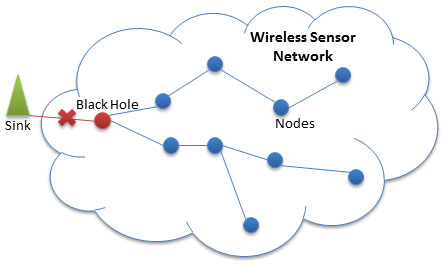Selective Forwarding attack in wireless sensor networks
Attackers can selectively or randomly drop packets and try to increase the rate of packet loss in the network.
Two ways to attack Selective Forwarding
Two ways bad guys can attack a network are:
- Attack from within
Authorized sensor node authentication can be compromised or bad guys can steal some keys or information from the nodes and attack the entire network. It is very difficult to detect such an attack.
- Attack from the outside
This is done by jamming the routing between legitimate nodes.

Types of Selective Forwarding Attacks
There are several types of Selective Forwarding attacks:
The malicious node prohibits the flow of information from the authorized nodes to the base station, thus leading to a DoS denial of service attack, which can be turned into a Black Hole attack by attacking the entire network and term Process the flow of information from every node to the sink (the node is responsible for interacting with the sensor nodes).
Unauthorized nodes skip forwarding information and randomly drop them off. Instead, the unauthorized node sends their own packets of information to other nodes. One such attack is called Neglect and Greed.
Another form of attack is when unauthorized nodes delay the messages passing through them to falsify routing data between nodes.
- The last type is the Blind Letter attack. When a packet is forwarded from a legitimate node to a malicious one, it ensures to the legitimate node that the information is forwarded to the next node and eventually discard the packet without being detected. This scheme can attack various multistep routing protocols such as Geographic routing, TinyOS beaconing, etc.
Detect and prevent Selective Forwarding attacks
Detection and containment are classified according to an implementation plan or on the basis of a defense plan:
I. On the basis of the nature of the implementation plan, it is divided into two sub-parts: Centralized and distributed.
In centralized plans, the head or sink part of the sensor nodes is responsible for detecting and preventing this attack. In distributed plans, both the base station and the cluster head are responsible for preventing such an attack.
II. On the basis of a defense plan, they are divided into the following 2 parts: detection and prevention
The prevention plans are not able to detect the attack or the faulty nodes, instead, they ignore the faulty nodes and remove them from the network. Detect type is capable enough to detect an attack or a faulty node or even both.
How to resist a Selective Forwarding attack
There are different plans to combat such attacks:
A security plan that detects the attack and pushes the alarm level up, using multi-step validation from different sensor nodes in the network. In this plan, both the source node and the base station can detect the attack and make the right decision even if one of them is compromised.
This follows a distributed approach and can detect if any malicious node tries to drop the packet, instead of forwarding it to the next node. The accuracy of this method is claimed up to 95% in detecting Selective Forwarding attacks.
Intrusion detection system (IDS) can detect any loophole exploited by an attacker and warn the network about the malicious nodes involved. IDS system is designed based on detection capabilities based on specification.
This technique uses a Watchdog approach, in which the neighboring nodes can monitor the node's activity and see if it forwards the actual packet to other nodes. If it ignores the actual packet, the counter increases and generates an alarm when this value reaches a certain limit. If multiple watchdog nodes generate an alarm, the base station is notified and the compromised node is discarded.
A distributed containment plan that uses multi-step confirmation to counter Selective Forwarding attacks. In this scheme, it is assumed that all sensor nodes know their location and the number of faulty nodes, the energy level of the network is known or estimated.
All data paths are inferred by an indeterminate logic taking into account energy restriction and faulty nodes will be present. In cases where the multipath routing protocol cannot provide authentication information, the propagation restriction method will be used.
- Another plan uses hexagonal mesh topology. The routing algorithm is applied to find the best packet path. Nodes near the routing path check the communication of neighboring nodes, locate the attacker, and resend these ignored packets to where it is supposed to be reachable.
This method clearly shows the Selective Forwarding attack, which in turn warns neighboring nodes about the attacker's location and ignores the attacker's node in forwarding other messages. This method ensures authentic data is provided, while also consuming less energy and space.
You should read it
- 3 ways to disable USB Selective Suspend in Windows 11
- Learn about Wireless Sensor Network (WSN)
- What is Port Forwarding?
- How to set up Port Forwarding in Windows
- How to set up Port Forwarding on Draytek router
- How to Find Your Selective Service Number
- How to set up Port Forwarding on Netgear router
- How to prevent email forwarding in Outlook and Gmail
May be interested
- What is Sensor Network Architecture?
 sensor network architecture is used in wireless sensor network (wsn). it can be used in various places such as schools, hospitals, buildings, roads, etc. for various applications such as disaster management, security management, crisis management, etc. …
sensor network architecture is used in wireless sensor network (wsn). it can be used in various places such as schools, hospitals, buildings, roads, etc. for various applications such as disaster management, security management, crisis management, etc. … - What is PetitPotam Attack? How to overcome PetitPotam attack
 petitpotam is a new attack method with the ability to take control of a domain controller and then take over the entire windows domain.
petitpotam is a new attack method with the ability to take control of a domain controller and then take over the entire windows domain. - 3D ultrasound fingerprint sensor under Qualcomm's first screen in the world
 recently, qualcomm introduced the first 3d ultrasonic fingerprint sensor for smartphones at its annual snapdragon tech summit conference. this 3d ultrasonic sensor is able to read fingerprints through layers of interfering substances such as water or oil.
recently, qualcomm introduced the first 3d ultrasonic fingerprint sensor for smartphones at its annual snapdragon tech summit conference. this 3d ultrasonic sensor is able to read fingerprints through layers of interfering substances such as water or oil. - How to calibrate sensors on Android
 the sensor in the phone is something users don't notice, but you'll know when it stops working. a problematic sensor can cause serious problems for the application you use.
the sensor in the phone is something users don't notice, but you'll know when it stops working. a problematic sensor can cause serious problems for the application you use. - 4 tips for building better wireless networks
 how much performance do companies want to implement when they deploy a wireless network? these cases may not be enough - especially when wireless becomes a key part of the new data center infrastructure.
how much performance do companies want to implement when they deploy a wireless network? these cases may not be enough - especially when wireless becomes a key part of the new data center infrastructure. - How to set up Port Forwarding on Netgear router
 the netgear router uses numbered ports to allow or disallow specific types of traffic to the computer. some games or programs require port forwarding to function optimally.
the netgear router uses numbered ports to allow or disallow specific types of traffic to the computer. some games or programs require port forwarding to function optimally. - How to prevent email forwarding in Outlook and Gmail
 recently, following gmail, outlook also implemented new features for its users, both of which offer a feature to prevent forwarding email. if this feature is what you are looking for, please read the following article to know how to use it to prevent recipients from forwarding your email.
recently, following gmail, outlook also implemented new features for its users, both of which offer a feature to prevent forwarding email. if this feature is what you are looking for, please read the following article to know how to use it to prevent recipients from forwarding your email. - What is tire pressure sensor? Should I install it in a car?
 what is tire pressure sensor? how is it used? how much is the sale price? read the article of tipsmake.com for specific answers!
what is tire pressure sensor? how is it used? how much is the sale price? read the article of tipsmake.com for specific answers! - How to use call forwarding on iPhone and Android
 call forwarding is a way to transfer calls to another number. this feature is available on android and iphone, very easy to set up.
call forwarding is a way to transfer calls to another number. this feature is available on android and iphone, very easy to set up. - 7 troubleshooting tips for Wireless N networks
 in this tutorial we will show you some tips on troubleshooting to make your network work as best as possible for wireless n.
in this tutorial we will show you some tips on troubleshooting to make your network work as best as possible for wireless n.










 Besides Windows Defender, should users install other anti-virus and anti-malware software?
Besides Windows Defender, should users install other anti-virus and anti-malware software? Keysight's security expert warns against the new cyber attack process
Keysight's security expert warns against the new cyber attack process The security hole allows hackers to hack iPhone remotely, update iOS now
The security hole allows hackers to hack iPhone remotely, update iOS now How do I know if an application is using the phone's microphone?
How do I know if an application is using the phone's microphone? Google's free services are exploited by hackers for phishing campaigns
Google's free services are exploited by hackers for phishing campaigns